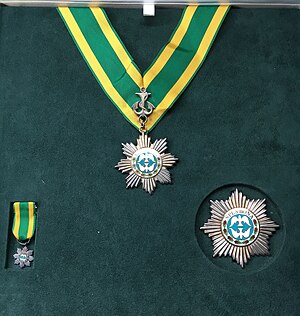Order of Good Hope
| Order of Good Hope | |
|---|---|
 Grand Officer set of the Order of Good Hope | |
| Awarded by | |
| Type | Order |
| Motto | Spes Bona (Latin, "Good Hope") |
| Awarded for | Foreigners for promoting international relations and the interests of South Africa. Between 1980 and 1988 it was also awarded to South African citizens. |
| Status | Dormant |
| Grades | Grand Cross Grand Officer Commander Officer Member (88-02) |
| Former grades | Grand Collar (73-88) |
| Statistics | |
| First induction | 1973 |
| Last induction | 2000 |
Ribbon bar of the order | |
The Order of Good Hope or Order of the Cape of Good Hope is a dormant order of merit of the Republic of South Africa.
History
The Order of Good Hope was founded in 1973, by the republican government of South Africa, to grant those who had distinguished themselves in the promotion of international relationships and to have sensibilised the general interest towards South Africa. It was abolished in 2002.
President Nelson Mandela had announced his intention to reform the Order. The new South African government saw the Order as a relic of apartheid, above all because the insignia was considered too European (the rays, the colours, the anchor and the Latin motto of the Order.[citation needed] The insignia was also costing the government around 11,000 rand per initiate.[citation needed] In its place was created the Order of the Companions of O. R. Tambo.
Classes
Awarded to foreign citizens (and, from 1980 to 1988, to South Africans too), for promoting international relations with the increasingly isolated apartheid state. The order was originally divided into five classes:[1]
- Grand Collar – for heads of state only.
- Grand Cross – for heads of government, ministers of state, judges, presidents of legislatures, secretaries of state, ambassadors, commanders-in-chief, and others.
- Grand Officer – for legislators, envoys, senior military officers, and others.
- Commander – for chargés d'affaires, consuls-general, colonels, and others.
- Officer – for consuls, lower-ranking military officers, and others.
The order was reorganised in 1988:
- Grand Cross – for excellent meritorious service (heads of state and, in special cases, heads of government).
- Grand Officer – for outstanding meritorious service (heads of government, ministers of state, judges, presidents of legislatures, secretaries of state, ambassadors, commanders-in-chief, and others).
- Commander – for exceptionally meritorious service (legislators, envoys, senior military officers, and others).
- Officer – for meritorious service (chargés d'affaires, consuls-general, colonels, and others).
- Member – for exceptional service (consuls, lower-ranking military officers, and others).
Notable recipients of the Grand-Collar (non-exhaustive list)
- Alfredo Stroessner, President of Paraguay in 1974[2]
- John McCain, United States Senator from Arizona in 1987
Notable recipients of the Grand-Cross (non-exhaustive list)
- Fredrick Chien, Vice Minister of Foreign Affairs of the Republic of China in 1979
- François Mitterrand, President of France in 1994 [3]
- Robert Mugabe, President of Zimbabwe in 1994 [3]
- Emperor Akihito of Japan in 1995 [4]
- Queen Elizabeth II, Former Queen of South Africa in 1995 [4]
- Zine El Abidine Ben Ali, President of Tunisia in 1995 [4]
- Joaquim Chissano, President of Mozambique in 1995 [4]
- King Mswati III of Swaziland in 1995 [4]
- Sheikh Isa bin Salman Al Khalifa (Bahrain) in 1995 [4]
- Sheikh Zayed bin Sultan Al Nahyan (United Arab Emirates) in 1995 [4]
- Queen Margrethe II of Denmark in 1996 [5]
- Queen Beatrix of the Netherlands in 1996 [5]
- Jacques Chirac, President of France in 1996 [5]
- Sam Nujoma, President of Namibia in 1996 [5]
- Muammar Gaddafi, Leader of Libya in 1997 [6]
- Hosni Mubarak, President of Egypt in 1997 [6]
- King Carl XVI Gustaf of Sweden in 1997 [6]
- Martti Ahtisaari, President of Finland in 1997 [6]
- Suharto, President of Indonesia in 1997 [6]
- Yoweri Museveni, President of Uganda in 1997 [6]
- King Harald V of Norway in 1998 [7]
- Bill Clinton, President of the United States of America in 1998 [7]
- Fidel Castro, President of Cuba in 1998 [7]
- Yasser Arafat in 1998 [7]
- King Juan Carlos I of Spain in 1999 [8]
- Queen Sofía of Spain in 1999 [8]
- Prince Claus of the Netherlands in 1999 [8]
- Sultan Qaboos bin Said al Said of Oman in 1999 [8]
- Jiang Zemin, President of China in 1999 [8]
- Boris Yeltsin, President of Russia in 1999 [8]
Sources
References
- ^ "Archived copy". Archived from the original on 2014-03-15. Retrieved 2012-11-02.
{{cite web}}: CS1 maint: archived copy as title (link) - ^ Portal Guaraní - ALFREDO STROESSNER MATIAUDA
- ^ a b 1994 National Orders awards Archived 2011-01-04 at the Wayback Machine
- ^ a b c d e f g 1995 National Orders awards Archived 2012-10-22 at the Wayback Machine
- ^ a b c d 1996 National Orders awards Archived 2012-11-13 at the Wayback Machine
- ^ a b c d e f 1997 National Orders awards
- ^ a b c d 1998 National Orders awards Archived 2011-01-04 at the Wayback Machine
- ^ a b c d e f 1999 National Orders awards Archived 2012-10-12 at the Wayback Machine
